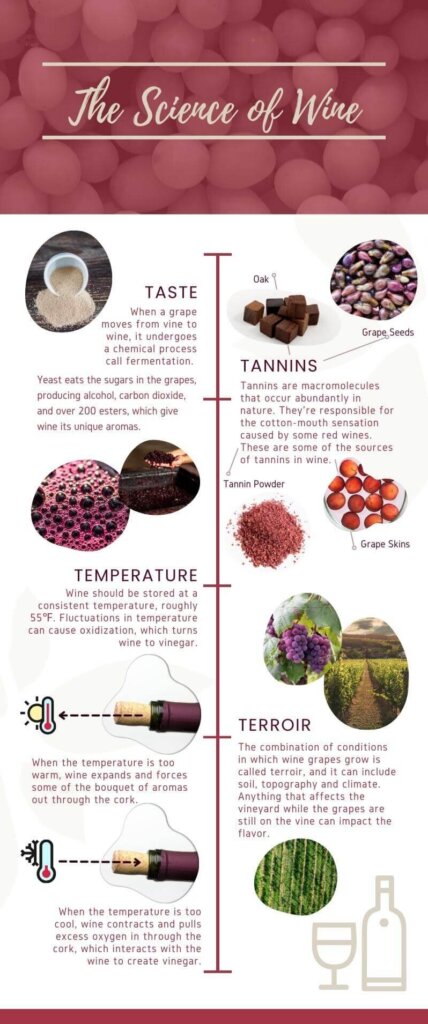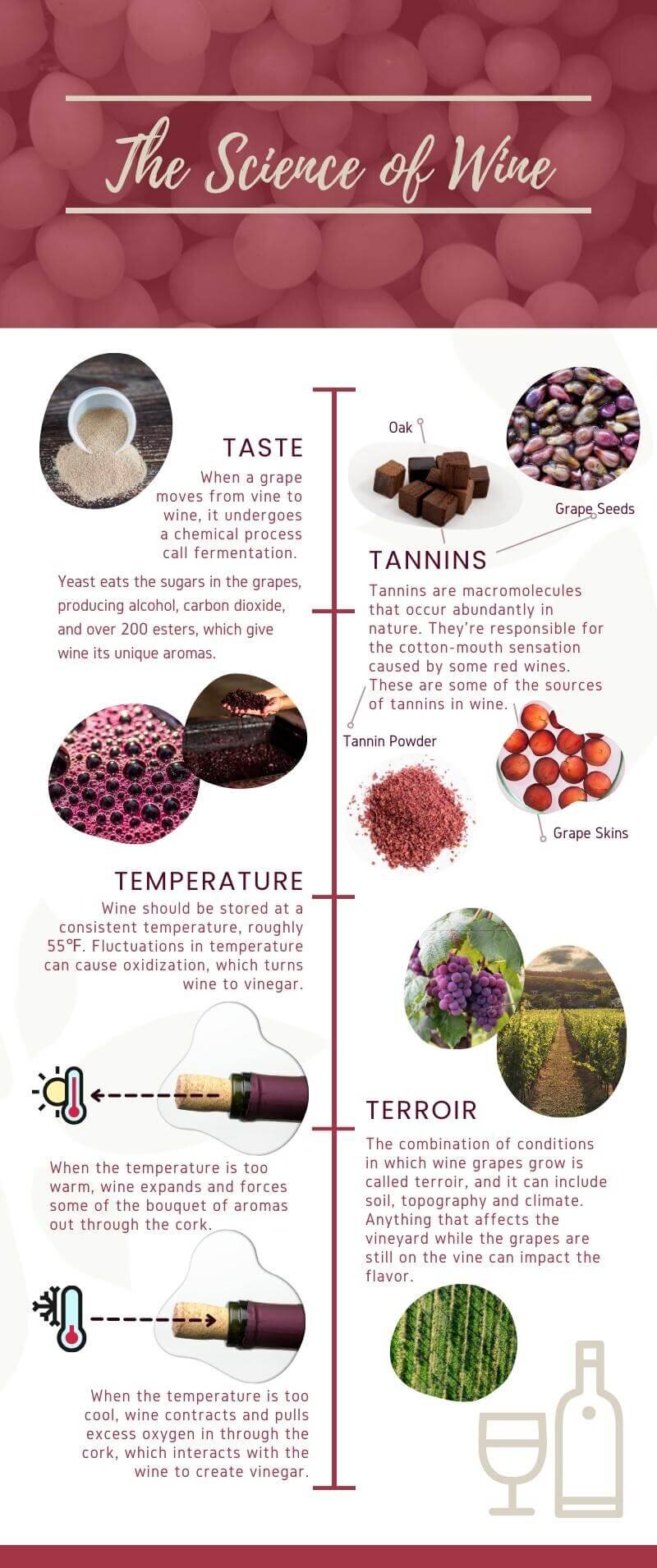Taste, tannins, temperature, terroir. What do these mean and how do they affect your wine tasting experience? We're here to take a peek at the science of wine. Let's explore the processes behind the grape's greatest achievement!
Taste & Tannins
When a grape moves from vine to wine, it undergoes a chemical process called fermentation. During this process, yeast eats the natural sugars in the grapes, producing a few byproducts: carbon dioxide, alcohol, and over 200 aromatic esters — organic compounds that are responsible for a wine's specific, unique aroma!
When you smell these aromas, your brain forms neurological connections that link the scent to existing memories: jasmine flowers, cherry plums, dark chocolate, apricots, and many more.
It's possible to like a wine's aroma without enjoying the flavor. This happens when your brain detects discrepancies between the smell and taste. For example, if a red wine smells like a plum but dries your mouth out, these sensations conflict and might be unpleasant. This dry-mouth phenomenon is caused by tannins, which are bitter and astringent macromolecules that occur abundantly in nature.
Plants create tannins to make themselves less palatable. If your mouth feels “coated” when you eat an underripe pear or plum, that’s because of the tannins in the fruit! The tannins in wine come from grape seeds and skins, which are often extracted before fermenting white wine varietals, which is why red wines tend to be "dryer" than white wines.
In the right quantities and at the right age, tannins can be smooth, velvety, and delicious, adding a layer of complexity to your wine. Tannins are also found in tea, coffee, and dark chocolate!
Temperature
Yes, the temperature of your wine does matter! But it may surprise you to learn that the stability of temperature is more important than the degrees themselves.
When temperature changes, wine expands and contracts far more than the bottle it's stored in. This causes changes in pressure, which can have a negative effect on wine: too much pressure, and some of the bouquet of aromas leaks out; too little, and the contraction of the liquid sucks some external air through the cork.
This brings in extra oxygen, which can react with alcohol to create acetic acid — also known as vinegar. Keeping the temperature consistent while storing wine can prevent this ebb and flow and keep your wine complex and delicious until you're ready to pop the cork.
Terroir
Champagne is not simply a bubbly white wine. A true Champagne is made according to very specific practices and comes exclusively from the Champagne region of France. You’ll know it by the letters “AOC” on the label.
In many countries, there are governing bodies that dictate when, how and where wine can be created. This is why a sparkling Italian white wine is called Prosecco, why Chianti must be made with at least 80% Sangiovese grapes, and why Napa Valley has become the wine lover’s vacation destination in the United States.
But why all the fuss over where a grape is grown? Wine will take on characteristics of the soil in which the grapes grow. In fact, even this is an oversimplification; in reality, anything that affects the vineyard while the grapes are still on the vine can impact the flavor!
The combination of conditions in which wine grapes grow is called terroir, and it can include soil, topography and climate. For example, a wine made from grapes in granite-rich regions like South Africa will produce what some might call a gravelly flavor profile. In addition, grapes grown in warmer regions produce more sugars. This doesn’t mean the wine will be sweeter, though! More sugars serve as extra fodder for yeast to turn into alcohol. That’s why wines produced in warmer climates tend to have a higher alcohol-by-volume content.
The science behind terroir hasn't quite been explained yet, but research into the subject has recently shifted from a descriptive approach to a technical approach. Scientists are using precision agricultural methodologies to investigate the mystifying relationships between grapes and the ground they're grown in.
Lucky for us, they're doing all the hard work. We just get to sit back and enjoy a nice glass of Cabernet at the end of the week and toast the scientists behind the scenes!
A Taste of Giving
Interested in learning more? Looking for a way to raise a glass to encourage our world's future scientists? Join us on April 27, 2024 for the Science of Wine!
Want to learn more about the science of wine? Here are some sources we used to learn more about the science behind the bottle:
- “The Science of Wine” by The Week Staff for The Week
- “What Are Tannins, Really?” by Heather Gordon for The Back Label
- “Central Italy” from the Court of Master Sommeliers
- “Unbiased Scientific Approaches to the Study of Terroir Are Needed” by Luca Brillante et al. for Frontiers in Earth Science Journal

